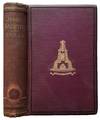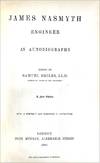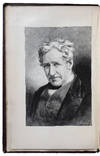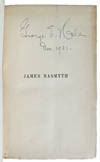signed
1885 · London:
by [NASMYTH, James (1808-1890)] Samuel SMILES (1812-1904).
London:: John Murray, 1885., 1885. Small 8vo. xx, 450, 8 pp. Frontispiece portrait, numerous figures, index, ads. Original full burgundy cloth – showing Nasmyth's STEAM HAMMER on the upper cover (emblazoned in gold) – with blind-rules on the rear cover, black-rules on upper cover, gilt-stamping on the latter and spine; front inner joint reinforced with kozo, spine label removed (lower spine). SIGNED BY GEORGE ELLERY HALE, Dec. 1921, bookplate of the Mount Wilson Observatory, with their embossed stamp. Generally good+. SIGNED BY GEORGE ELLERY HALE. Though the book is common, the signature of Hale makes this am important copy for those who appreciate the value of prior ownership. Hale was widely read, his personal library and that of his father as well, being ample evidence of the extent of the family collection, later absorbed into the Mount Wilson Observatory library collection (now dispersed). / New edition. James Hall Nasmyth (1808-1890) was an important Scottish engineer, philosopher, artist, and builder of some of the first the steam hammers. "A steam hammer is an industrial power hammer that uses steam to drive a piston, which in turn raises and then drops a hammerhead. It's primarily used for shaping forgings, driving piles, and other heavy forging tasks. The hammer was invented by James Nasmyth in 1839 and became crucial for large-scale engineering projects during the Industrial Revolution." [Wikip.]. / "Nasmyth was a highly talented machine builder, but he did not invent the steam hammer, nor was he the first to build one. In 1843, an acrimonious dispute arose between him and the engineer François Bourdon from the famous Le Creusot ironworks as to who was first with the idea. However, Nasmyth's ability as a self-publicist managed to obscure the origins of the invention. He promoted the new tool with energy, usually attending in person at the starting-up of a new hammer, or showing that it was so controllable that it could merely crack the top of an egg placed in a wine glass." – Science Museum Group.
(Inventory #: S14321)







